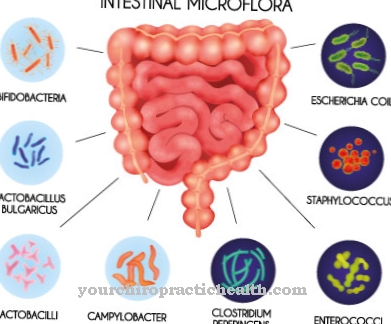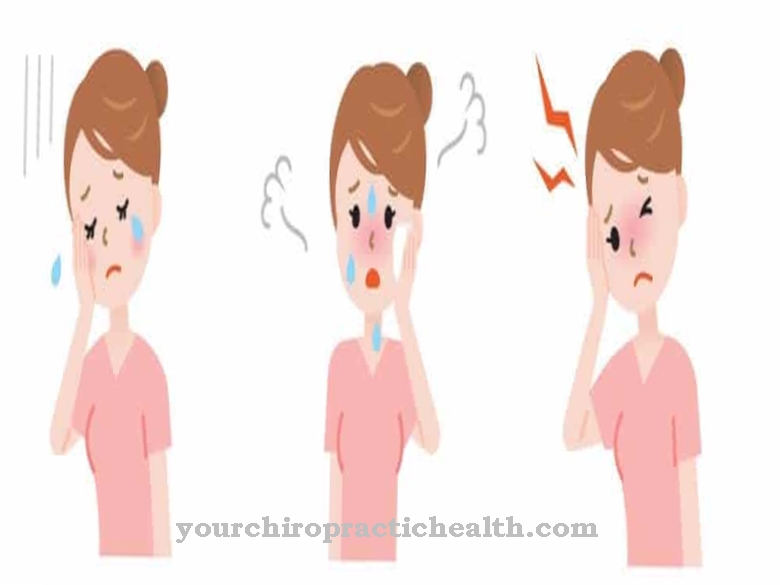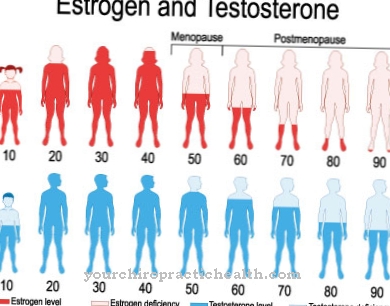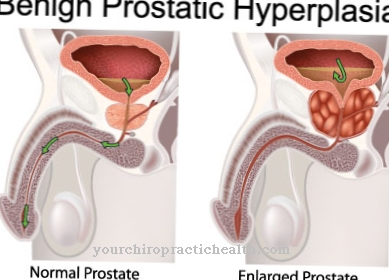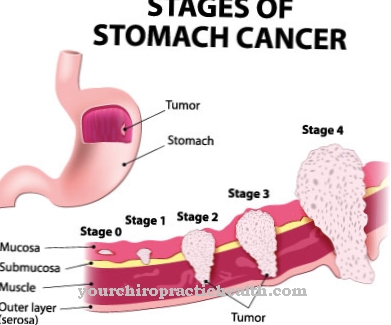The Corpus callosum agenesis is a hereditary disease and inhibition malformation with partial or total malposition of the cerebral bar. Those affected often show behavioral problems and can suffer from symptoms such as impaired vision and hearing. The agenesis is treated symptomatically as there is no causal therapy.
What is corpus callosum agenesis?

© Karen Roach - stock.adobe.com
The corpus callosum is a bar between the left and right hemispheres of the brain, also known as the brain bar. A person's cerebral bar consists of more than 200 million nerve fibers and plays a key role in the exchange of information and the coordination of the left and right cerebral hemispheres, which perform various tasks in information processing.
The corpus callosum agenesis is a hereditary disease from the group of agenesies. Such is the complete absence of a particular organ due to a genetic lack of predisposition. In corpus callosum agenesis, patients lack the cerebral bar between the two cerebral hemispheres. The malformation is one of the inhibitory malformations that precede any aplasias.
The lack of contact with the cerebral bar can result in serious disorders of the sensory systems and physical undesirable development as well as spasticity. Cooperation between the two halves of the brain is made difficult by the lack of the corpus callosum. The agenesis of the cerebral bar can occur symptomatically in the context of various malformation syndromes. The incidence is between 3: 1,000 and 7: 1,000.
causes
Agenesies usually go back to a genetically determined non-disposition. Although sporadic occurrences have been observed in connection with corpus callosum agenesis, the occasional occurrence in sibling pairs at least suggests that genetic factors are involved. According to the observations, hereditary corpus callosum agenesis is based on either an X-linked or an autosomal recessive inheritance.
In the meantime, medicine assumes that these inheritance patterns are up to ten percent. Four out of 50 children with the agenesis have chromosomal peculiarities. Most of these are abnormalities on chromosomes 8, 13 or 18. These abnormalities were mainly observed in patients with syndromes such as Patau syndrome, Edwards syndrome or triploidy.
A bar deficiency is not only found in people with the anomalies described. Reduced or non-applied bars were also found in people with chromosomal aberrations on chromosome three. All of the chromosomes mentioned are involved in the development of the corpus callosum. However, no single gene has yet been identified as the trigger for the agenesis.
Symptoms, ailments & signs
Some patients with CCA are completely absent from birth. In others, the separation of the two halves of the brain is simply underdeveloped or incomplete. In addition to hearing impairment, symptoms such as visual impairment can occur in the context of the deformity, which can range up to blindness. Some patients also have hydrocephalus.
In the case of a water head, the pressure in the brain can be dangerously high. Sometimes micrencephaly is also observed in patients with corpus callosum agenesis, which is equivalent to an incorrect development of the additional brain mass and is associated with mental retardation. In addition to epilepsy, spasticity or decreased muscle tone, symptomatic short stature can also be present in CCA.
The agenesis can occur in the context of various malformation syndromes and is then associated with the specific symptoms of the respective syndrome. Aircade syndrome and oro-facio-digital syndromes are among the most common malformation syndromes associated with agenesis of the cerebral bar.
In addition to chromosomal abnormalities, corpus callosum agenesis can occur in the context of metabolic diseases, viral embryopathy or abnormalities of the cranial fossa. CCA patients almost always suffer from behavioral problems or attention difficulties.
Diagnosis & course
The corpus callosum agenesis is a congenital malformation that manifests itself in early childhood at the latest. In addition to a diagnosis after manifestation, a prenatal diagnosis is possible from the 20th week of pregnancy. Diagnostic imaging methods such as transfontanel sonography, magnetic resonance tomography and cranial computed tomography are possible diagnostic instruments. The prognosis varies greatly from case to case.
The most relevant prognostic factor is whether the malformation is isolated or is a symptom of a syndrome that causes further symptoms. The development prognosis for patients with baragenesis can speak for an almost symptom-free future with isolated agenesies. In other cases, the most severe physical and cognitive disabilities can occur, especially in the case of bar agenesies in the context of syndromes.
Complications
Various complaints and complications can occur with corpus callosum agenesis.In most cases, however, there are behavioral disorders and impairment of hearing and vision. As a rule, the restrictions do not appear suddenly, but instead lead to a constant reduction in these perceptions over the course of the disease.
Complete blindness or complete hearing loss can also occur. In many cases, the increased brain pressure leads to headaches and undesirable developments in the brain. Because of these undesirable developments, behavior disorders and other psychological complaints occur. The corpus callosum agenesis often occurs with short stature.
The patients suffer from metabolic diseases and have a reduced quality of life. Concentration is also reduced, so that there is usually a reduced intelligence. The causal treatment is not possible because it is not possible to recreate the cerebral bar.
For this reason, behavioral and learning therapies are mainly used so that the patient's intelligence is not reduced by the corpus callosum agenesis. Speech therapy must also be carried out in many cases. If epileptic seizures occur, the brain pressure must be reduced. In rare cases, the corpus callosum agenesis does not lead to any complaints or complications.
When should you go to the doctor?
Parents of sick children should always consult a doctor closely. The doctor can determine the severity of the corpus callosum agenesis and, in the event of unusual symptoms, initiate treatment or call a specialist. If the child shows behavioral disorders or signs of other psychological problems, a therapist must always be consulted. If signs of a metabolic disease are noticed, an internal medicine specialist should be consulted. In the case of ataxias and other restricted mobility, physiotherapy and occupational therapy are possible.
Other symptoms should also be quickly clarified by the respective specialist and treated if necessary. Due to the multitude of complaints and symptoms that can occur with corpus callosum agenesis, parents should put together a team of doctors as early as possible. The first point of contact, however, is the pediatrician, who can closely monitor the course of the disease. In the event of serious complications, it is best to contact the emergency medical service. The parents should also seek psychological support as soon as the child's illness poses increasing physical as well as emotional stress.
Doctors & therapists in your area
Treatment & Therapy
A causal therapy for bar agenesis does not yet exist. The missing cerebral bar cannot be reconstructed. For this reason, treatment for patients with corpus callosum agenesis is purely symptomatic and is heavily geared towards the individual complaints. For example, if there are behavioral problems, psychotherapy or behavioral therapy is indicated.
In the case of ataxias or other physical restrictions on movement, physiotherapy and occupational therapy can be used as countermeasures. A lack of muscle tone can also be increased by strengthening the muscles through physiotherapy. Language and learning restrictions can also be symptoms of the disease. Due to the lack of connection between the two halves of the brain, for example, the patient's attention is often restricted.
Such abnormalities can be regulated with attention training if necessary. In addition to the above-mentioned therapeutic options, speech therapy can be used against language problems. Anticonvulsant treatment is also conceivable as symptomatic therapy in some cases. If there are additional symptoms such as water head or epilepsy, these symptoms may be preferred for treatment.
A reduction in intracranial pressure is vital for a water head with increased intracranial pressure, for example. Treating epilepsy can be just as important. In some cases of isolated corpus callosum agenesis, no therapeutic measures are required because patients remain symptom-free and normal for life.
Outlook & forecast
The prognosis of corpus callosum agenesis is often poor. The hereditary disease is not considered curable or treatable due to legal and medical possibilities. Nevertheless, the occurrence of the disease in the offspring of the sick is sporadic. Not all children of sick parents have an outbreak of corpus callosum agenesis. In addition, the individual complaints in the affected patients are individual in their nature and severity. Therefore, they do not have to be the same as those of other family members.
| An affected mother wrote to us:
"Our child was diagnosed with a fold in the neck that was too large. The further examinations showed an isolated partial bar deficiency and an abortion was recommended. I can only say that, thank God, we decided against the abortion. Our son is now 4 years old and very healthy . Our child has nothing negative to say about it. On the contrary, he speaks much more clearly and deliberately than most other children his age and he has a super happy and contented demeanor. Unbelievable that it is him, at least according to a doctor As we have experienced all of this, we get the impression that medicine itself does not yet know enough about it. In a normal ultrasound examination at the gynecologist, the bar deficiency cannot be determined at all. How many people with something like that Nobody knows life. Very few are examined so thoroughly. My recommendation: Don't go crazy ma let it go. " |
Depending on the severity of the symptoms, individual therapy is carried out to alleviate the individual complaints. Nevertheless, despite great efforts and immediate treatment after the birth of the child, the corpus callosum agenesis does not achieve freedom from symptoms. In the case of a slight malformation, the quality of life and well-being of the patient can be significantly improved with great effort and regular participation in various therapeutic measures offered.
If the patient's intracranial pressure increases in the course of life, the likelihood of a life-threatening condition increases. In addition, it can lead to further brain damage, which significantly worsens the state of health. Most patients experience irreparable harm from the tissue damage. In addition, many of those affected suffer from other diseases that contribute to a deterioration in health. Due to the functional disorders of individual sensory systems, the patient needs lifelong care and medical care.
prevention
The responsible gene and the exact circumstances for the corpus callosum agenesis have not yet been identified. For this reason, the malformation cannot be prevented so far.
Aftercare
In the case of corpus callosum agenesis, there are usually no or only very few follow-up measures available to those affected, since this disease is a hereditary disease. If the patient wishes to have children, genetic testing and counseling should be carried out so that the disease does not recur in the children.
The corpus callosum agenesis cannot be treated completely, so that the person concerned is entitled to purely symptomatic treatment. In most cases, the symptoms of this disease are limited by means of physiotherapy. Many of the exercises from such a therapy can also be performed in your own home.
The affected children depend on the support and intensive care of their parents and relatives in their lives. Intensive and loving conversations also turn out to be very positive and can also prevent psychological upsets or depression.
Speech therapy is also often necessary for this disease, whereby the parents must clearly support the child here too. In corpus callosum agenesis, regular examinations by a doctor are necessary. Whether the disease will lead to a reduced life expectancy for the patient cannot be universally predicted.
You can do that yourself
Since corpus callosum agenesis is a congenital damage to the brain, it is not possible for the affected child to carry out self-help activities to support his or her well-being. If the disease sets in in adulthood, the options are also very limited.
Due to the existing symptoms, such as behavioral problems and disorders of the sensory systems, the child is given medical care in the first few months of life and is often looked after by people in the immediate vicinity. In everyday life, the mental and emotional support of relatives should therefore not be disregarded with this disease. These are exposed to particular challenges and can take advantage of self-help measures.
It is important not to lose courage and optimism despite the fateful illness of one's own child or partner. Your own social life should continue to take place and be adapted to the new conditions. Social withdrawal leads to a decreased mood among the relatives. Since they spend a lot of time looking after and caring for the sick person, they need rest and recovery phases in order to maintain their own reserves of strength.
Comprehensive information about the disease is important in order to be informed about its development, treatment options and symptoms. At the same time, your own psychological limits should be observed and you should be considerate of yourself.

.jpg)
